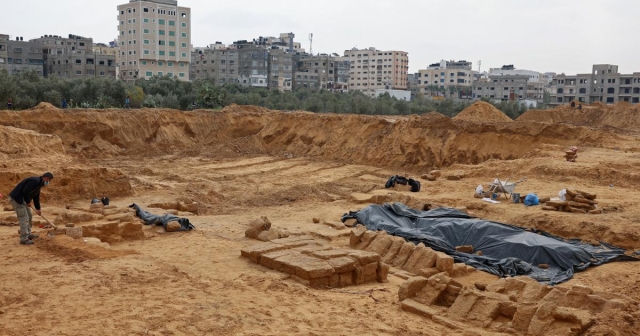While construction workers were digging at a site in the Gaza Strip, a security guard noticed a strange stone protruding from the ground. At first, he thought it was a tunnel dug by one of the terrorist members from Hamas, but as it turned out, it was a Roman necropolis from about 2,000 years ago.
Following Operation Guardian Of The walls in May last year, Egypt began a $ 500 million rehabilitation initiative in Gaza. As part of the rehabilitation project in Jabalya, in the northern Gaza Strip, bulldozers dug in the sandy soil to build new structures.
Gaza, part of the territory that Israel ceded in 2005 in exchange for a peace that never manifested, is thought to have many rich archaeological sites buried underneath, many of which have no doubt been destroyed by terror tunnels that have been the primary work of Hamas, using international funds meant to help the impoverished people of Gaza.
The recent findings are part of an ancient necropolis dating around 2,000 years ago. "I informed the foremen about the findings, and they immediately contacted the local authorities and asked the workers to stop the work," said Ahmad, a Palestinian who preferred not to give his full name for fear of retribution by Hamas for speaking to a western media outlet.
While workers labored on a large construction site in the Gaza Strip, a security guard noticed a strange piece of stone sticking out of the earth. Investigations revealed the find was a 2,000-year-old #Roman underground necropolis. #Archaeology https://t.co/8Ud7D3XY32
— Ancient Pages (@AncientPages) June 26, 2022
The story of a great discovery began to spread on social media, while the Gaza Antiquities Authority called on the French NGO Premiere Urgence Internationale and the French School of Biblical and Archeology in Jerusalem to assess the importance of the site and mark the area. Prior to Israel's withdrawal from the area, the Israel Antiquities Authority which is among the best archaeology institutions in the world would have led the efforts, however since Hamas wrestled control of the strip from the Palestinian Authority, there is no cooperation with Israel at all.
"The first excavations allowed the identification of about 40 tombs from the ancient Roman period between the first and second centuries AD," said French archaeologist Rene Alter, who led the team sent to Jabalya.
"The necropolis is larger than these 40 tombs and should contain between 80 and 100 tombs." One of the burial sites found is decorated with colorful paintings representing crowns and wreaths of bay leaves as well as jars meant for drinks like wine and beer.
Another article on cultural heritage and archaeology in the Gaza Strip, from AFPhttps://t.co/0YIWEaYtBQ
— Michael Press (@MichaelDPress) June 26, 2022
A fence has been raised around the Roman necropolis, while guards are constantly monitoring the area, with new structures are being built nearby. Hamas' funds have been depleted as Western countries and Arab ones who have pivoted towards Israel have cut off financing the terror organization after it was revealed that humanitarian funds were being used to build missiles and tunnels. During tight times, Hamas often turns to the black market to sell drugs, stolen goods, and even antiquities so the concern they have for this site is surprising.
"We are trying to fight the antiquities trade," said Jamal Abu Rida, director of the local archeological service, which is in charge of protecting the necropolis and hopes to find investors for further excavation. Ironically, Abu Rida's department is under the Hamas governing body so his assurances are being met with some level of skepticism. "Gaza's image is often associated with violence, but its history is replete with archeological treasures that need to be protected for future generations," said Jihad Abu Hassan, the director of a humanitarian mission in the Gaza Strip.
Gaza is a tiny and dense strip whose population has increased in 15 years from 1.4 million to 2.3 million people. Due to the vast population growth, building construction accelerated. "Some people refrain from telling the authorities if there is an archeological discovery at a construction site for fear that they will not be rewarded for it or harm the work sequence at the site.


